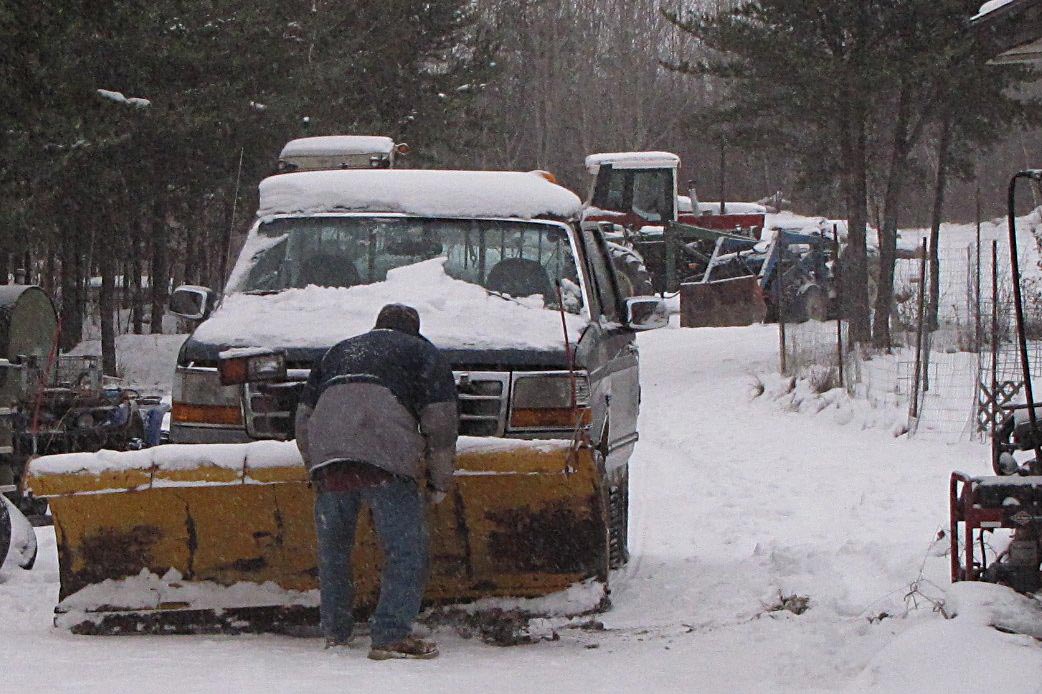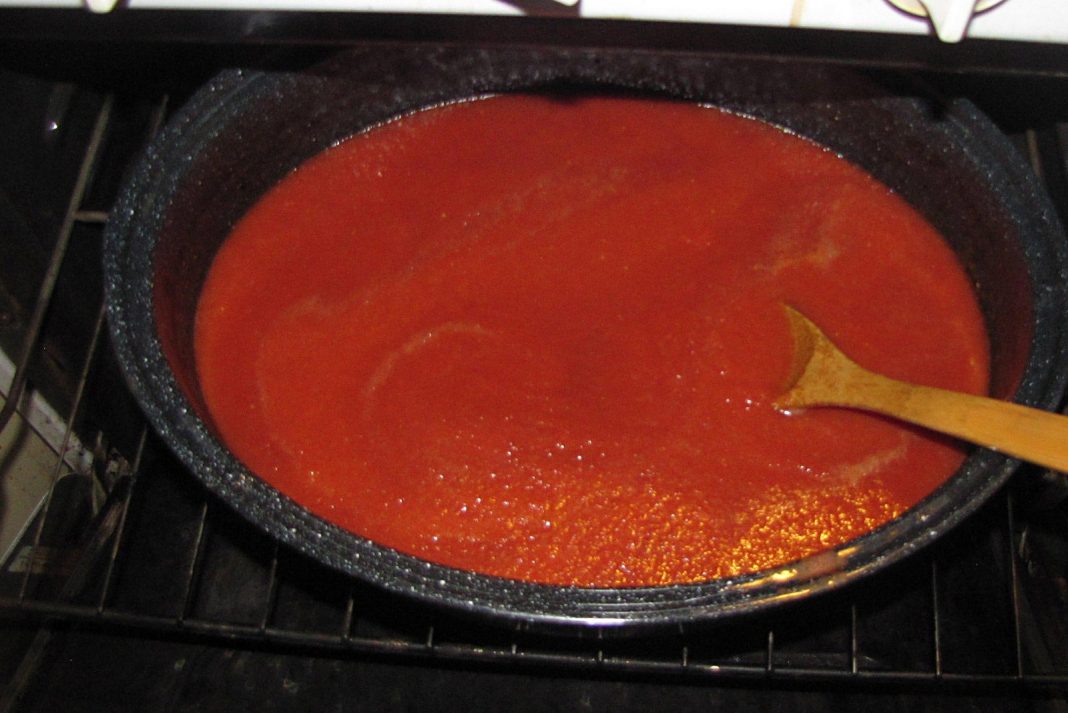I know early November is really “fall” but we got our first snow weeks ago and it’s still with us. And then we got a foot more … and today it’s snowing again. So Will went up and hooked the snowplow onto our old Ford 4×4 truck and made a couple passes out our mile-and-a-half-long driveway. We always wait awhile and let the snow pack down on the dirt and gravel drive so when we plow we don’t toss this valuable asset off into the woods where it is not needed. But enough is enough! Now we have a plowed driveway, courtesy of Hondo and Will.

Meanwhile, I’ve continued grinding tomatoes in our Victorio tomato strainer and cooking down the puree for various sauces. Today I’m going to make another batch of barbecue sauce. It’s so easy and tasty and we use a lot throughout the year. I even use it on meatloaf instead of catsup. (If you’d like a couple of recipes, check out my Growing and Canning book.) Where I’ve always made such sauces, it wasn’t until relatively recently I thought “why not grow more paste tomatoes to reduce the cooking down of juicy tomatoes?” Pretty elementary, huh? So I did just that. Our little seed business trialed several new paste tomatoes and I was thrilled at how thick the sauce was. And this year, I tried mixing a few different tasting tomatoes to make my sauces. After all, not all tomatoes taste the same … or even close to the same. I made my last batch using chiefly G. Chalmers Paste and Bill Bean with Jaune Flamme and Dejena Lee’s Golden Girl mixed in. Both of those golden tomatoes have wonderful, fruity, complex flavors. And so does the puree from them! I really am excited about this discovery — talk about designer sauces. (If you’d like to grow some super tomatoes, check out my article “Tomatoes — queen of the garden” in the Twenty Fourth Year Anthology for lots of tips.)

And, believe it or not, I’ve started scanning through seed catalogs … even before I’ve got our Seed Treasures website revamped for 2018. We haven’t even gotten our tomato cages pulled and I’m sorting out new varieties for us to trial. (We had better get the new garden by the training ring barn up and running for next spring, hadn’t we?) — Jackie




Hey, Jackie. Are you still willing to answer questions on this blog? Because I have one for you. My cabbage crop was great this year. Here in the northeast, we are in our usual chilly November; no real bone-chilling cold yet. Is it OK to leave the cabbages unpicked in the garden (night lows in the 20s and low 30s, day highs in the 40s), and pick it as we need it? I sure want to do what’s best, as this cabbage is amazing. Jeanne
Yes, I am willing to answer questions here. I’m glad you had such good luck with your cabbages. I believe if it were me, I’d go ahead and pick those cabbages as you’re getting down to where the cold could get worse and affect the texture and taste of the cabbage.
THanks, Jackie! And Happy Thanksgiving to you and all your family!
DonnaB,
We always store squash and pumpkins in warmer areas. I found they rotted much sooner if I put them in the cool basement pantry.
Thanks, Jackie. This is helpful. I was always under the impression they had to be stored in “root cellar” temperatures. Going to try room temp instead.
Regina and Draza,
Here’s your answer to your problem with your lemon juice and Clear-Jel turning hard when you make canned apple pie filling;
Yes, this can happen. But it doesn’t seem to matter. To prevent this, just mix the Clear-Jel with your sugar and spices then add all to your apple juice or water before you boil it. This will thicken it fine.
Hi Jackie,
Have been lurking and reading for many years. Enjoy it!
I raised the Hopi Grey Squash this year. I planted a few seeds, rather late, but was blessed with 2 mature squashes. What is your method for “seasoning” the squashes for winter storage? Thanks.
Joyce in SE Ohio
We just hold our squash at room temperature, NOT in the root cellar cool temperatures, for a month before starting to eat them. They are much sweeter this way. (This goes for all winter squash.) Then the Hopis will store for a year or even two in many cases.
Jackie, after you store the squashes for a month at room temperature, do you move them to cool storage in the root cellar? Or just keep them at room temperature?
Hahaha! Great (growing) minds think alike! I placed my first seed order this morning! Farm on!
I can’t wait for the 2018 Seed Treasures as I’ve seen several plants I would like to try including that new paste tomato with the funky shape. I hope you will have seeds for it. So enjoy your Growing and Canning Book and look forward to canning more next year.
I’m busy at work, updating our website, seedtreasures.com, right now. As we have a lot of new things, we’ve redone it to allow for more pictures. As soon as I’ve got that done, the catalog’s the next project.
Miss Jackie, Some of us can scarcely wait to read the next installment of the saga of our old buddy Jess Hazzard! Not that your cooking and canning books aren’t good, But I NEEEED a Jess Hazzard FIX. His adventures and your writing skills together are nearly addictive! Rick
Good news, Rick! I sent the fourth book, Spring of the Vultures, on to Mason Marshal Press this morning. Now I get to plot out the next book…. Mmmmm
Dawn, buy Jackie’s “growing and canning” book …. or any of her others for fantastic recipes of all kinds. You’ll love it.
I totally agree about her canning book. Because she cans everything she grows for her family to eat, I feel she’s the last word on canning anything.
Please, can you share your homemade BBQ recipe? Would love to have it.
Dawn,
I actually make three (or more!) barbecue sauces. (As Joyce said, you can find them in my book, Growing and Canning Your Own Food, on pages 114-116) But here’s the basic barbecue sauce:
1 gallon chopped, peeled, cored tomatoes
2 C chopped onions
1 C chopped sweet green peppers
1 C chopped sweet red peppers
1 hot red pepper, powdered or chopped (optional)
1 C (or more to taste) brown sugar
1 C vinegar
2 cloves garlic, minced
1 Tbsp paprika
1 tsp salt
1 Tbsp dry mustard
1 tsp Liquid Smoke
Combine vegetables in large pot. Simmer until tender. Run through food mill or blend until smooth. Place in a large pot and simmer until reduced by one half. Add remaining ingredients to puree. Simmer, stirring frequently to prevent scorching until as thick as you wish. Keep tasting and add more brown sugar to taste, if you wish. Ladle hot sauce into hot jars, leaving 1/4 inch of headspace. Process for 20 minutes in a boiling water bath canner.
Comments are closed.